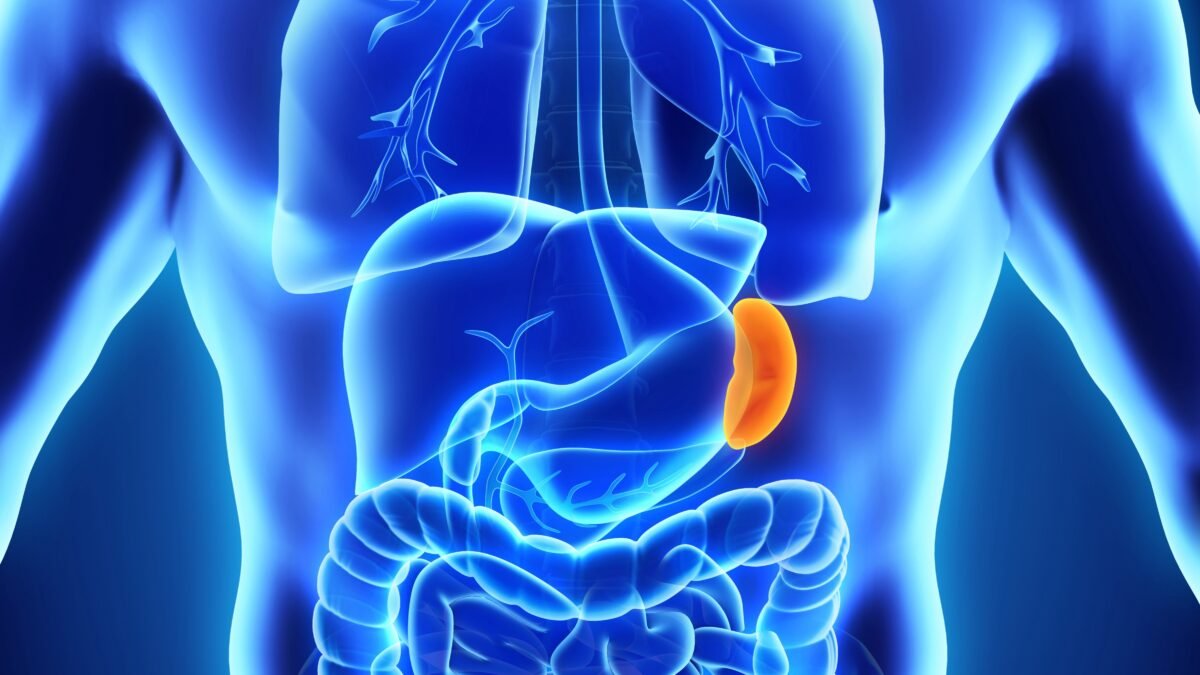Your Miraculous Spleen Works Tirelessly, Cleaning Your Blood and Protecting Against Viral Assaults
In this series, “The Miraculous Immune System,” we explore the true power of our immunity and the organs that work tirelessly to protect us. We also provide practical ways to protect these vital divine gifts.
Previously: The lymphatic system not only is an indispensable protector, but also could be a hidden path for toxins to spread throughout the body. It can be a spreading route for COVID-19 vaccines, which are linked with severe life-threatening events in the brain and heart.
If the body were a country, the lymphatic system would be the garbage processing system, and the spleen, for the blood circulation system, would be a general command station with an arms factory, a central recycling station, and a supervising checkpoint.
The spleen, the largest lymphatic organ in the human body, plays a critical role, especially during the COVID-19 era. It’s one of the least understood organs of the human body.
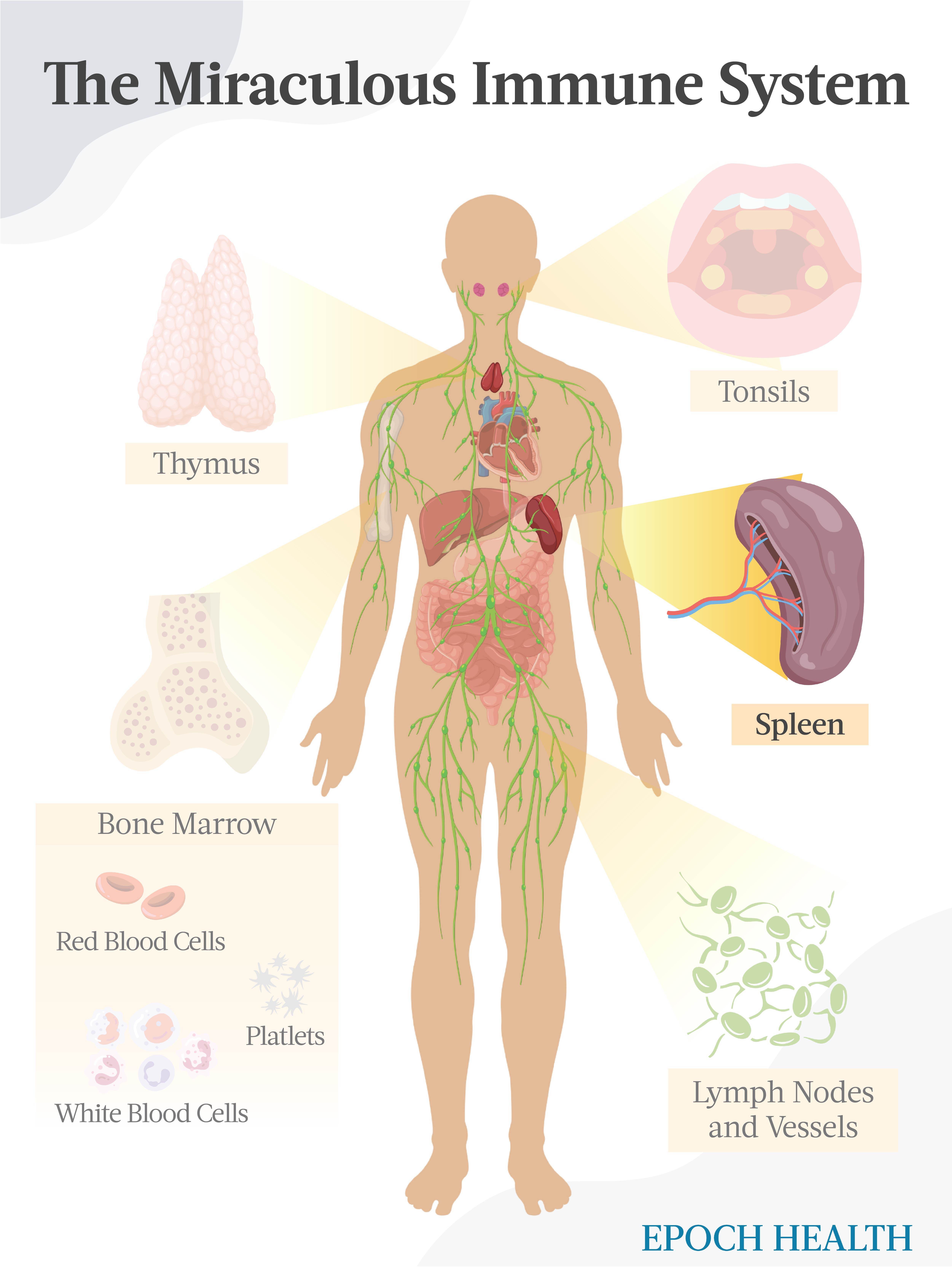
The ‘Odd’ Spleen
The spleen is a reddish-purple, coffee bean-shaped, fist-sized organ that sits under the rib cage on the left side of the abdomen, next to the stomach.
Curiously, it’s linked with a series of “odd” numbers: 1, 3, 5, 7, 9, and 11. The spleen is about 1 inch thick, 3 inches wide, 5 inches long, weighs approximately 7 ounces, and lies between the ninth and 11th ribs.
The spleen is primarily composed of two types of tissues: the red pulp, which contains red blood cells and venous tissues; and the white pulp, which contains white blood cells that regulate inflammation and play an important role in fighting pathogens.
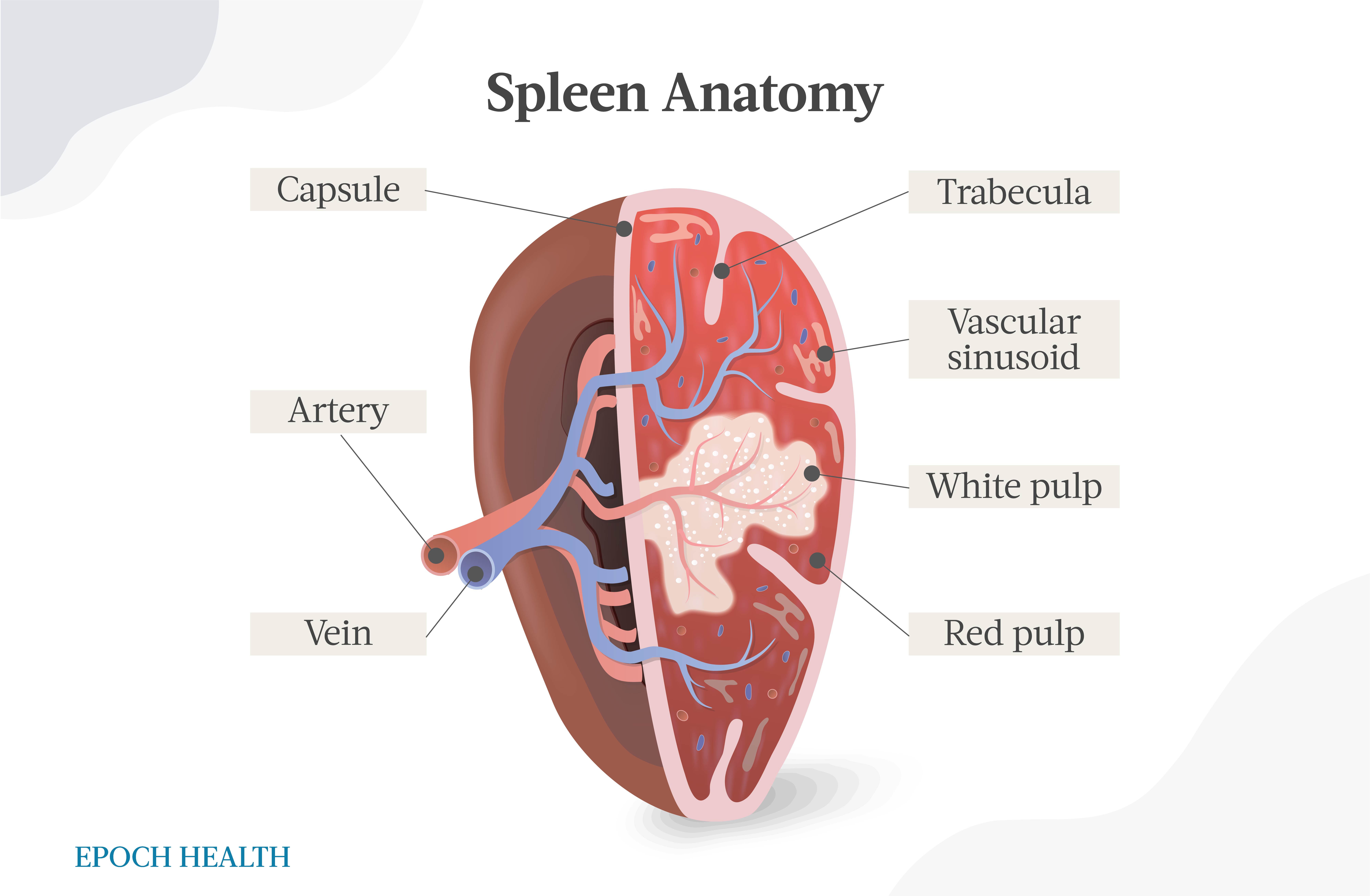
A Multifunctional Vital Organ
Although small in size, the spleen performs a multitude of critical functions. It exemplifies the marvel of the human body’s ability to use one thing for many purposes.
Sitting like a reservoir in the circulatory system, the spleen primarily regulates immune defense functions, produces antibodies, and filters the blood to remove pathogens, especially encapsulated germs. These are bacteria that are double-protected, more resistant to the body’s immunity, and more invasive (e.g., Streptococcus pneumonia).
The spleen also removes old blood cells and helps control the amount of blood that circulates throughout the body, while creating critical blood reserves that can be released during trauma and significant bleeding.
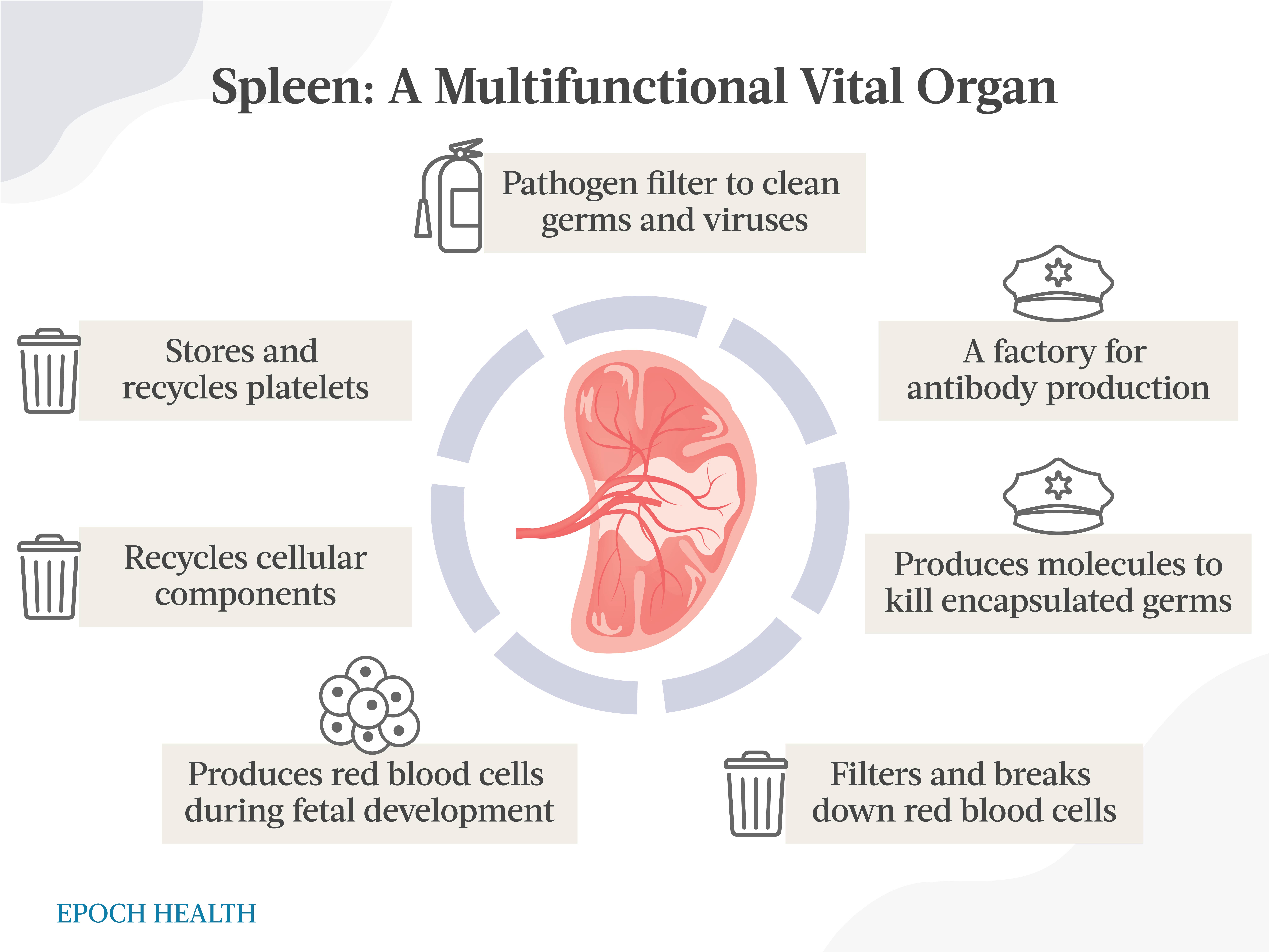
The spleen has three primary functions.
Filtering Blood to Remove Invading Germs and Viruses
Pathogens will usually be neutralized or destroyed by the lymph nodes. However, any pathogens that manage to evade filtration will continue to circulate within the lymph flow and will eventually be recirculated in the blood.
Once in the blood, there is another efficient filter to remove these harmful agents—the spleen. As blood passes through the spleen, pathogenic components such as debris, bacteria, and parasites are rapidly eliminated, keeping the blood clean.
This is mainly done within the spleen’s abundant lymphoid tissue—i.e., “white pulp”—with the help of macrophages, which are powerful scavengers that engulf and degrade dead cells, debris, tumor cells, and foreign materials.
During a chronic infection, and similar to the lymph nodes, the spleen may become inflamed from the accumulation of pathogens, causing it to increase in size.
Additionally, B cells, a type of white blood cell, produce infection-fighting proteins called antibodies that can attack bacteria. This antibody production of B cells is one of the most important contributions of the spleen to immunity.
Producing and Recycling Red Blood Cells
The body contains three main types of blood cells: red blood cells, white blood cells, and platelets. The spleen has the essential function of generating and recycling red blood cells, which keeps our blood healthy and clean.
From weeks 12 to 28 of fetal development, the spleen produces most of the red blood cells. After week 28, the bone marrow takes over and becomes the primary site for producing red blood cells.
The average lifespan of human red blood cells is approximately 120 days in circulation, after which they are engulfed by macrophage scavengers.
This is an extremely efficient process, as macrophages engulf about 5 million red blood cells every second without any significant leakage of red blood cell components into circulation.
The blood in the spleen flows through a unique network that is designed to carry out this cleaning process. Imagine the spleen as a factory and the splenic microcirculation as the assembly line. Blood enters the factory through the small splenic blood vessels and passes through a meshwork called the red pulp, which is like a quality control station that checks each blood cell for damage.
Think of macrophages as workers on the assembly line who remove any cells that don’t pass the quality check. As the blood cells pass through the red pulp and into the meshwork, they get squeezed and pressed.
Squeezing helps to identify any damaged cells that may have passed the quality control test. If the cells are damaged, they rupture, and the spleen’s cells digest the components that are released.
The products of that digestion are mainly reused by the body as nutrients, often for making new blood cells.
Creating Extra Blood Reserves
Another critical function of the spleen is its ability to release extra blood reserves in a crisis. In cases where the body experiences issues with blood supply, such as shock or loss of blood volume, the spleen can shrink in size and release up to 100 milliliters of blood into other areas of the body for circulation, which is 2 percent of the body’s entire blood volume.
Unexpected COVID-Related Spleen Outcomes
In COVID-19 patients, doctors usually don’t examine the spleen, even though it may be significantly affected by the virus, so its compromised condition could go unnoticed until a major issue arises.
How SARS-CoV-2 Can Decimate the Spleen
A postmortem autopsy study found that SARS-CoV-2 infection can involve pathological changes in lymph nodes and the spleen, which can cause severe cellular damage and a decrease in immune cells.
The study found that SARS-CoV-2 can damage the spleen and lymph nodes by infecting them directly or by triggering the production of interleukin 6 (IL-6). This can lead to the death of immune cells, shrinkage of the spleen nodules, and a decrease in lymphocytes.
The study also found that a protein called fatty acid synthase (FAS), which regulates cell death, was significantly increased in virus-infected spleens compared with healthy ones.
The research shows that SARS-CoV-2 can infect the spleen and affect the immune system, not just the lungs. This helps explain why COVID-19 patients may experience severe spleen-related outcomes.
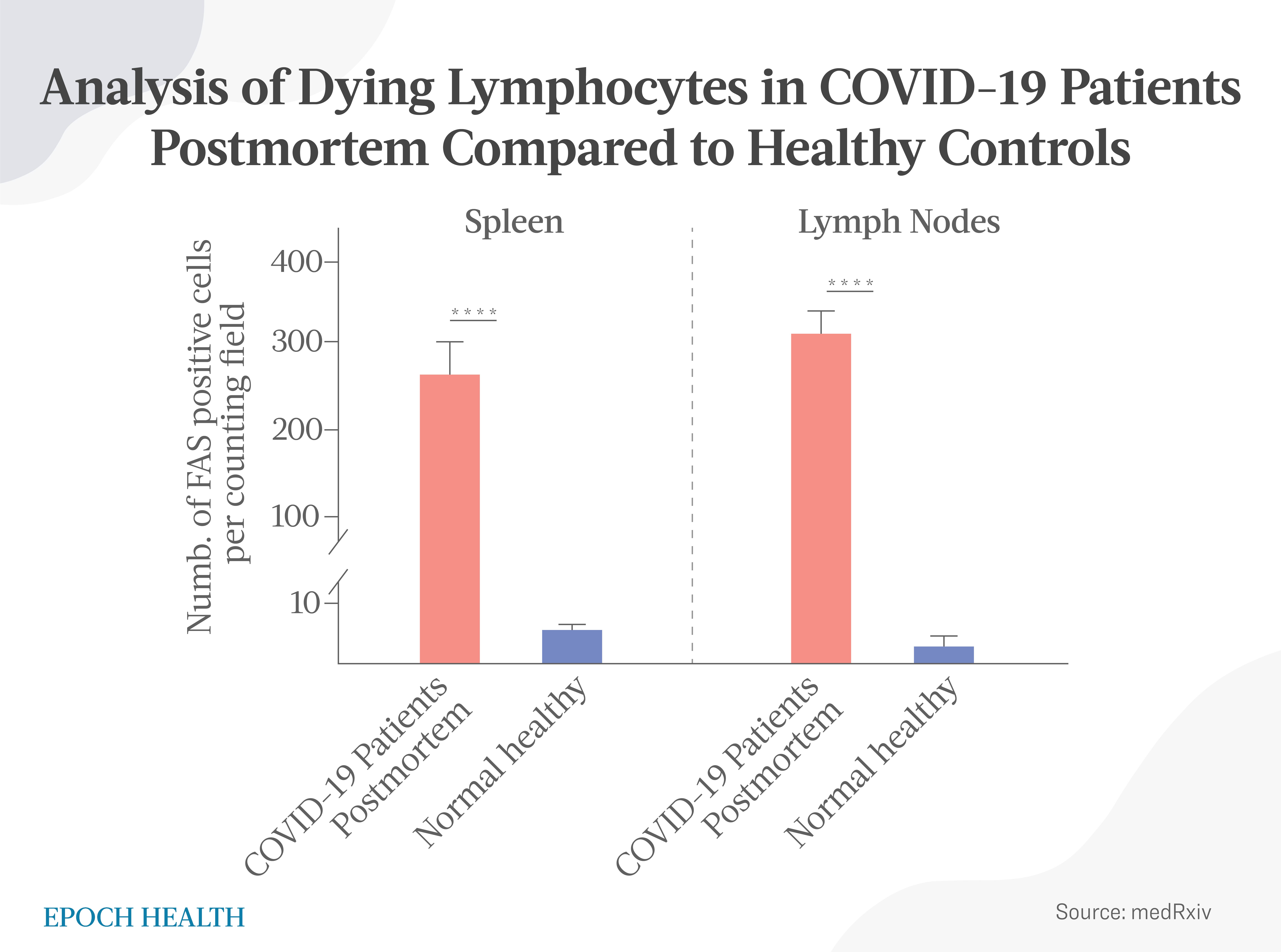
COVID-19 Infection Can Affect Spleen Size
A study looked at 160 acute COVID-19 patients and found that their spleen size and volume significantly increased during the early stage of hospitalization. This may be because of the body’s immune response or other factors. The severity of the COVID-19 infection was also related to spleen enlargement.
Another study found that patients who recovered from COVID-19 had significantly smaller spleen sizes than healthy individuals. Additionally, the number of infection-fighting T cells in the body was lower in patients with severe pneumonia than in those with moderate pneumonia.
Both studies highlight the significant effect of COVID-19 on the spleen. The difference in spleen size between the two studies can be explained by the different stages of COVID-19 and the effects on infection-fighting cells, inflammation, and blood cells.
COVID-19 Can Cause Spleen Rupture and ‘Stroke’
The spleen is the most highly vascularized organ in the body. Any serious injury or bleeding from the spleen can result in significant blood loss, leading to a lack of homeostasis, and in some cases, even death. Injuries to the spleen are common in blunt abdominal trauma.
Similar to a stroke in the brain or heart, the spleen can also have a “stroke.” This often occurs when the splenic artery or its branches are blocked by a blood clot.
During the past three years, research has found quite a number of COVID-19 cases with spleen “stroke” reported worldwide:
These all may be because COVID-19 can cause blood clotting in small blood vessels in the spleen, which can lead to the death of spleen tissue. In some cases, the spleen can even break on its own, resulting in a rupture.
Cases of spontaneous nontraumatic spleen rupture secondary to COVID-19 disease have been reported in several countries, including the United States, Iran, Italy, the United Kingdom, and Saudi Arabia.
These severe cases remind us again that COVID-19 can increase the risk of blood clots in different parts of the body, including the heart, brain, and an often-forgotten organ—the spleen.
The symptoms of a brain stroke and a heart stroke are widely known, but the symptoms of a spleen stroke, with a potentially life-threatening outcome (spleen rupture) aren’t commonly recognized.
Left-sided abdominal pain, with or without nausea and vomiting, should be carefully monitored to exclude the possibility of spleen infarction. When the spleen is ruptured, it often must be surgically removed.
Next: Did you know that surgically removing the spleen can lead to a severe infection with a high risk of mortality? That’s why it’s crucial to understand how to protect this vital organ and keep it healthy.
Read Part 1: The Silent Gatekeepers of Your Immunity Many People Don’t Know Of
Read Part 2: Tonsillectomy: A ‘Minor’ Procedure With Major Long-Term Risks
Read Part 3: Many People Have Removed an Important Body Part, Which May Increase 4 Cancer Risks
Read Part 4: Beyond Detox: Unlocking the Secret Healing Power of the Lymphatic System
Read Part 5: Building a Strong Defense: Boost the Lymphatic System and Detoxify After COVID-19 Vaccines
◇ References
Kapila V, Wehrle CJ, Tuma F. Physiology, Spleen. [Updated 2022 May 8]. In: StatPearls [Internet]. Treasure Island (FL): StatPearls Publishing; 2023 Jan-.
Sadarangani, M. (2018). Protection Against Invasive Infections in Children Caused by Encapsulated Bacteria. Frontiers in Immunology, 9.
Bohnsack, J. F., & Brown, E. J. (1986). The Role of the Spleen in Resistance to Infection. Annual review of medicine, 37, 49–59.
Tahtabasi, M., Hosbul, T., Karaman, E., Akin, Y., Konukoglu, O., & Sahiner, F. (2021). Does COVID-19 cause an increase in spleen dimensions? Possible Effects of Immune Activation, Hematopoietic Suppression and Microthrombosis. Clinical imaging, 79, 104–109.
Agus M, Ferrara ME, Bianco P, Manieli C, Mura P, Sechi R, et al. Atraumatic Splenic Rupture in a SARS-CoV-2 Patient: Case Report and Review of Literature. Case Rep Surg 2021;2021:1–5.
Shaukat I, Khan R, Diwakar L, Kemp T, Bodasing N. Atraumatic splenic rupture due to covid-19 infection. Clin Infect Pract 2021;10:100042.
Mobayen M, Yousefi S, Mousavi M, Shafighi Anbaran A. The presentation of spontaneous splenic rupture in a COVID-19 patient: a case report. BMC Surg 2020;20:220.
Knefati M, Ganim I, Schmidt J, Makkar A, Igtiben S, Landa E, et al. COVID-19 with an initial presentation of intraperitoneal hemorrhage secondary to spontaneous splenic rupture. (pdf) Cureus 2021;13:e15310.
Prentice G, Wilson S, Coupland A, et al. Complete splenic infarction in association with COVID-19. BMJ Case Reports CP 2021;14:e246274.
Guyton and Hall Textbook of Medical Physiology (pdf). Saunders. 2010. Pp. 195, 196, 201, 202. ISBN 978-1416045748.
Page 191: These reservoirs include the following: (1) the spleen, which sometimes can decrease in size sufficiently to release as much as 100 ml of blood into other areas of the circulation.
Billett HH. Hemoglobin and Hematocrit. In: Walker HK, Hall WD, Hurst JW, editors. Clinical Methods: The History, Physical, and Laboratory Examinations. 3rd edition. Boston: Butterworths; 1990. Chapter 151.
Thiagarajan, P., Parker, C. J., & Prchal, J. T. (2021). How Do Red Blood Cells Die? Frontiers in physiology, 12, 655393.
Al Suwaidi S, Alakasheh B, J, Al-Ozaibi L, S: Splenic Infarction in a COVID-19 Patient without Respiratory Symptoms. Dubai Med J 2022;5:74-77. doi: 10.1159/000521207
Robinette, C. D., & Fraumeni, J. F., Jr (1977). Splenectomy and subsequent mortality in veterans of the 1939-45 war. Lancet (London, England), 2(8029), 127–129.
Santos Leite Pessoa, M., Franco Costa Lima, C., Farias Pimentel, A. C., Godeiro Costa, J. C., & Bezerra Holanda, J. L. (2020). Multisystemic Infarctions in COVID-19: Focus on the Spleen. European Journal of case reports in internal medicine, 7(7), 001747.
Thrombotic disease as a complication of COVID-19 must be suspected by clinicians, and recognized and monitored by radiologists. Thrombosis is often the initial manifestation of SARS-CoV-2, hence the importance of early diagnosis to avoid complications and reduce morbidity and mortality.
Mobayen, M., Yousefi, S., Mousavi, M. et al. The presentation of spontaneous splenic rupture in a COVID-19 patient: a case report. BMC Surg 20, 220 (2020).

